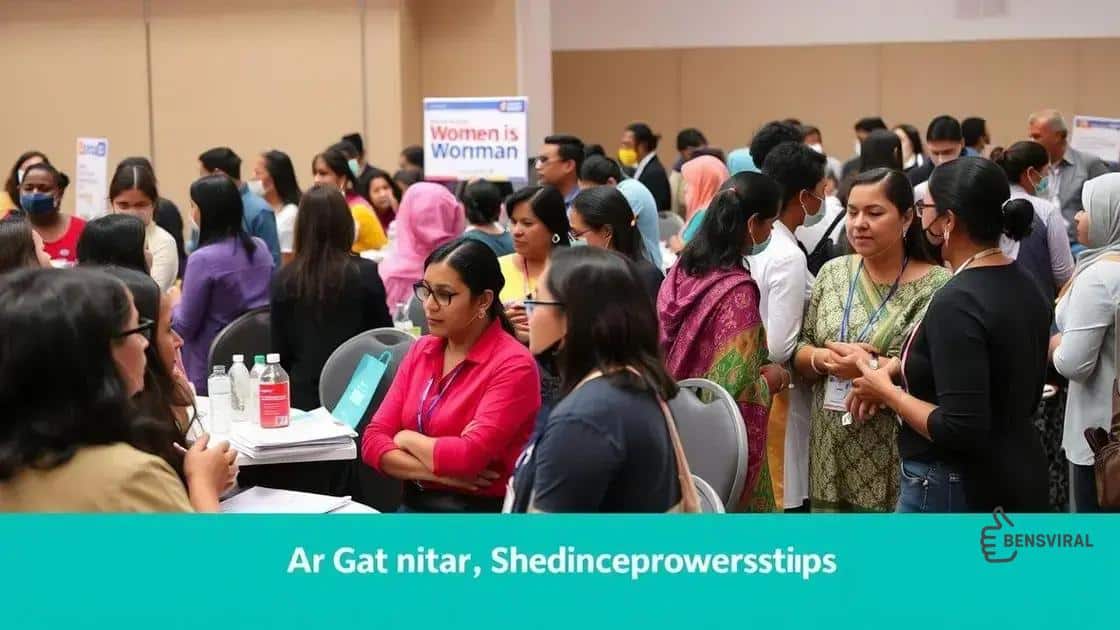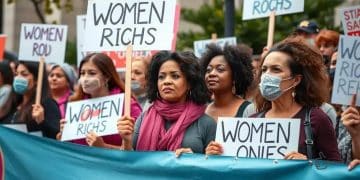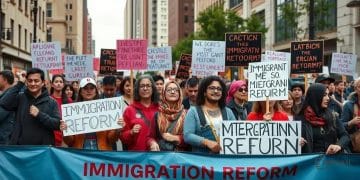Women’s rights advocacy and mobilization efforts explained

Women’s rights advocacy involves grassroots movements, organizations, and individual efforts to address challenges, raise awareness, and create impactful policy changes aimed at achieving gender equality.
Women’s rights advocacy and mobilization efforts play a crucial role in shaping social justice. Have you ever wondered how these initiatives impact everyday lives? Let’s dive into their significance.
Understanding women’s rights advocacy
Understanding women’s rights advocacy is essential for recognizing how these efforts contribute to social justice. Advocacy goes beyond mere awareness; it mobilizes resources and individuals to push for meaningful change. It shapes policies, fights against discrimination, and promotes equality.
The goals of women’s rights advocacy
Advocacy focuses on several critical goals:
- Promoting equal access to education and healthcare.
- Combatting violence against women.
- Ensuring fair representation in political and economic spheres.
- Addressing discrimination in workplaces and society.
These goals illustrate the comprehensive nature of the movement. Each goal targets specific issues that women face daily. By raising awareness and mobilizing communities, advocacy helps break down barriers.
Methods of advocacy
Advocacy employs various methods to reach its objectives. Grassroots movements often start at the local level, harnessing the power of community. Social media campaigns raise awareness on a wider scale, connecting people across the globe. Legal challenges fight against unjust laws.
These methods can work independently or in unison. For example, a community organization may utilize social media to collect support for a legal challenge. This synergy amplifies the message and engages a broader audience.
Another effective strategy involves forming partnerships with other organizations that share similar goals. Collaborations can enhance the impact of advocacy efforts. By working together, groups can share resources, knowledge, and networks. This not only strengthens campaigns but also fosters solidarity among different movements.
In summary, understanding women’s rights advocacy involves recognizing its goals and methods. It’s a multifaceted approach that seeks to create lasting change. Ongoing efforts are vital in addressing the issues women face, ensuring their voices are heard and valued.
The role of mobilization in driving change
The role of mobilization in driving change is crucial in the context of women’s rights advocacy. Mobilization refers to the process of bringing people together to work towards a common goal. It empowers individuals to stand up for their rights and influences policymakers to implement necessary changes.
Why mobilization matters
Mobilization helps to create a strong voice for women’s rights. When people unite, they can amplify their message significantly. This collective action draws attention to issues that might otherwise be overlooked. Furthermore, it engages communities and builds support networks.
- Increases visibility of women’s issues.
- Encourages community involvement.
- Strengthens advocacy campaigns.
- Fosters solidarity among diverse groups.
Mobilization also plays a vital role in educating the public about women’s rights. Through campaigns, workshops, and community events, individuals learn about their rights and the importance of advocacy. This education motivates people to participate and can lead to more informed citizens.
Strategies for effective mobilization
Successful mobilization requires strategic planning and execution. Here are some proven strategies:
- Utilizing social media to reach a wider audience.
- Organizing local events to engage community members.
- Building partnerships with other organizations.
- Creating clear and compelling messages that resonate with supporters.
These strategies help ensure that mobilization efforts are effective. By leveraging these approaches, advocates can create meaningful change in their communities.
Additionally, effective mobilization fosters a sense of belonging. When individuals feel part of a larger movement, they are more likely to engage and contribute their efforts. This sense of community is essential for sustaining long-term activism. Overall, the role of mobilization in driving change is both significant and impactful, showcasing the power of unity in the fight for women’s rights.
Key organizations championing women’s rights

Key organizations championing women’s rights play a vital role in advancing social justice. These groups work tirelessly to support women through advocacy, education, and empowerment. Their influence is seen in many areas, including legal reforms and public awareness campaigns.
Notable organizations making a difference
Several organizations are at the forefront:
- UN Women: This global entity focuses on gender equality and the empowerment of women. It provides support to countries to create policies that uplift women.
- Amnesty International: This organization campaigns for human rights worldwide, including women’s rights. They work to address issues like violence and discrimination.
- The Global Fund for Women: They fund initiatives that help women and girls. This organization amplifies grassroots movements focused on change.
- Planned Parenthood: Known for reproductive rights, they offer health services to women. They advocate for women’s rights to choose and provide education on reproductive health.
These organizations engage in various activities that strengthen the movement. For instance, they provide legal support, create educational programs, and offer resources for advocacy.
The impact of these organizations
The impact of these groups is profound. They strive to change laws, shape public opinion, and empower women at the grassroots level. By highlighting issues that matter, they build momentum for campaigns that seek to create real change. Grassroots activism often collaborates with these organizations to broaden the reach of their initiatives.
Moreover, these organizations often empower women to become leaders in their communities. By providing training and resources, they encourage women to take action on issues affecting their lives. The collaboration between organizations and local activists enhances advocacy efforts tremendously. This partnership fosters a community of support, ensuring that women’s voices are heard.
Overall, understanding the role of key organizations championing women’s rights is essential in recognizing the multifaceted approach to advocacy. Their efforts are crucial in building a more equitable society.
Grassroots movements and their effectiveness
Grassroots movements are vital in the fight for women’s rights. These movements empower individuals at the local level to advocate for change. By mobilizing communities, they create a foundation for lasting impact.
What are grassroots movements?
Grassroots movements originate from the community, driven by ordinary people rather than large organizations. They focus on local issues that directly affect individuals. This approach builds strong connections and encourages participation. Grassroots efforts allow members to voice their concerns and advocate for change in a way that resonates with their communities.
- Fostering community involvement.
- Raising awareness of local issues.
- Encouraging individual leadership.
- Creating networks for support and collaboration.
Through these connections, grassroots movements can turn awareness into action. They often bring attention to marginalized voices and address unique challenges that may be overlooked by larger organizations.
Success stories from grassroots movements
Many successful grassroots movements have led to significant changes. One notable example is the Women’s March, which started as a community initiative and grew into a global phenomenon. This movement mobilized millions to advocate for women’s rights and social justice. Its effectiveness lies in community engagement, which empowers participants to stand together for a common cause.
Another powerful grassroots initiative is #MeToo, which highlights the experiences of sexual harassment and assault. This movement has sparked essential conversations and brought about policy changes across various industries. By sharing personal stories, grassroots movements create a shift in societal awareness and expectations.
These examples illustrate how grassroots movements can effectively raise awareness and enact change. By uniting individuals around common issues, they foster a sense of solidarity and responsibility to advocate for one another. Grassroots efforts play a crucial role in nurturing active participants who contribute to the larger women’s rights movement.
Challenges faced in advocacy efforts
Challenges faced in advocacy efforts for women’s rights are numerous and complex. Advocates work hard to overcome opposition, misconceptions, and systemic barriers. Understanding these challenges can help improve strategies and increase effectiveness.
Common obstacles in advocacy
One major challenge is resistance from those who oppose change. This resistance can come from individuals, groups, or even institutions. Often, fear of losing power or privilege drives this opposition. It can manifest in various ways, such as lobbying against favorable legislation or spreading misinformation.
- Limited funding: Many advocacy groups struggle with inadequate financial resources, which hinder their ability to effectively operate and promote their initiatives.
- Cultural barriers: Gender norms and stereotypes can limit advancement efforts, leading to pushback from conservative segments of society.
- Lack of awareness: Many individuals are unaware of the issues women face, which can slow the progress of advocacy campaigns.
- Legal hurdles: Navigating laws and regulations can be complicated, often restricting advocacy actions.
These obstacles create a challenging landscape for advocates. Efforts to promote women’s rights can feel daunting when facing such resistance. However, successful advocacy has often emerged from unwavering determination and innovative approaches.
Building resilience against challenges
Overcoming challenges requires building resilience within the movement. Organizations often focus on education and outreach to raise awareness. By sharing information and personal stories, they can engage the public and foster understanding. This grassroots approach empowers individuals to contribute to the cause, amplifying the message of advocacy.
Networking is another critical strategy. By forming coalitions with like-minded organizations, advocates can pool resources and efforts. These partnerships strengthen campaigns and increase their reach, making advocacy more impactful. Collaborating also helps in sharing best practices and overcoming common challenges together.
Advocacy for women’s rights is not without its difficulties. Yet, the resilience of the movement, supported by collective action and education, paves the way for progress. Addressing these hurdles head-on and refining strategies ensures that advocacy efforts remain effective and relevant.
women’s rights faces various challenges, but the resilience of grassroots movements and organizations fosters hope and progress. By overcoming resistance, forming partnerships, and raising awareness, advocates can create a significant impact. The journey may be tough, yet collective efforts remind us that change is possible, and everyone has a role in the fight for equality.
FAQ – Common Questions about Women’s Rights Advocacy
What are grassroots movements in women’s rights advocacy?
Grassroots movements are community-driven efforts that aim to advocate for women’s rights and bring about local change.
How can I get involved in women’s rights advocacy?
You can get involved by joining local organizations, participating in events, or raising awareness through social media.
What challenges do women’s advocacy groups face?
They often encounter resistance, limited funding, cultural barriers, and legal hurdles that can hinder their efforts.
Why is education important in women’s rights advocacy?
Education raises awareness about women’s issues, empowers individuals, and encourages community participation in advocacy efforts.






